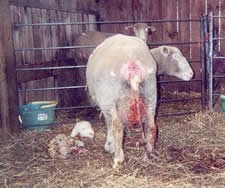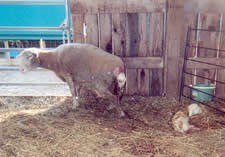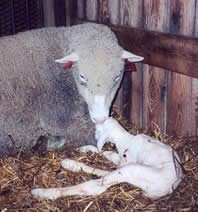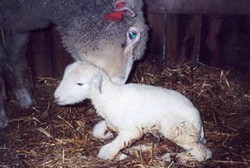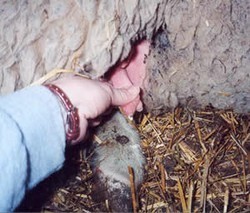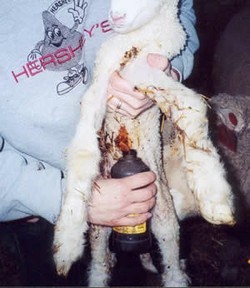|
During the birth process, once the water breaks you should soon see the appearance of the front feet. |
This ewe has already given birth to her first lamb and is ready to give birth to another lamb. |
|
The lamb's head should lay above and between the front legs in a normal presentation. The feet should also be pointing downward in a normal presentation. Feet that are pointing upward are generally from a breech birth. Lambs can be born in the breech position, but you will want to be sure to have the birth progress rapidly. As soon as a breech-positioned lamb is born, hold him up by his back legs and rub down his sides to help remove any fluid from his lungs. |
A closer inspection of the ewe shows that the feet are positioned correctly and are pointing downward. |
|
The next step in the birth process is the appearance of the head. Most of the time a thin membrane will still cover the lamb. This membrane should break as the lamb is born. However, you may want to be nearby if the lamb needs assistance. If the birth is progressing, allow nature to take its course. Only assist if necessary. Remember that a young ewe who is giving birth to her first lambs will take more time to complete the birth process than an older, more experienced ewe. |
Shortly after the feet appear, the head should appear above and between the front legs. |
|
As more of the lamb appears outside of the ewe, allow the ewe to continue pushing until the lamb is completely born. When the ewe stands up, the umbilical cord will break on its own. Do not cut the cord as this is likely to cause excessive bleeding. Allow the cord to tear on its own. |
Allow the ewe to push the lamb out on her own. Also, be sure to let the umbilical cord tear on its own. |
|
Once the lamb is born, check to make sure that it is breathing. Wipe the head and nose off well to make it easier for the lamb to breathe. If the lamb is not breathing, try inserting a piece of straw a short way into a nostril to encourage the lamb to sneeze. You may also need to lift the lamb up by the rear legs and vigorously rub its sides. In cold weather, it is also a good idea to dry off the ears and tail as best as possible. This helps to prevent freezing. Allow the mother to lick the lamb to clean off the rest. She should be "talking" to her lamb now that he is born. |
Use a towel to dry off the lamb's head and nose. This will help him to breathe easier. |
|
If the mother is still lying down, move the lamb toward her head so that she can lick off the lamb. This is a bonding process for the mother and lamb to identify each other. They will need to be able to identify each other once they are turned out with a group of ewes and lambs. Do not move the mother and her new lamb into a lambing pen until she has given birth to all her lambs. A ewe that is forced to lamb inside the smaller sized lambing pen runs a higher risk of laying down on the first lamb that was born while she is giving birth to the second lamb. Lambs who are born outdoors on pasture don't have to be brought inside to a lambing pen. Use your best judgment based on how well the ewe is caring for her newborns. |
Allow the ewe to lick her lamb. This helps clean off the lamb as well as helps the mother to identify her offspring. |
|
A vigorous lamb will soon be trying to stand up. For weaker lambs, they may need a few minutes longer (sometimes up to an hour) before they are ready to stand up to nurse. You may want to give any weaker lambs a dose of a high energy/vitamin and mineral drench to provide extra energy until they are able to nurse on their own. Once the ewe has finished giving birth to all of her lambs, she can be moved into a smaller lambing pen for several days. This gives her additional time to bond with her lambs and allows you to keep a closer watch on the lambs to make sure they are getting enough milk to drink. |
A vigorous lamb will soon begin trying to stand |
|
Your last tasks once the mother and lambs are in the lambing pen are to check her teats to make sure they are open and to check that the mother has milk. Another task is to dip the lamb's navel in iodine to prevent any navel infections. |
Check the ewe's teats to make sure they are open and to make sure the ewe has milk.
Dip the lamb's navel in iodine to prevent a navel infection. |
Source: Sheep Home Study Course, Penn State Extension, http://extension.psu.edu/courses/sheep/reproduction/the-process-of-lambing/the-birth-process
Click here to view a video that explains the birth of a Dorper lamb
